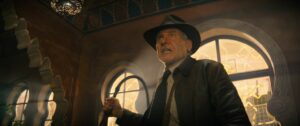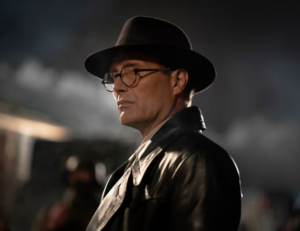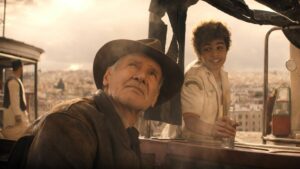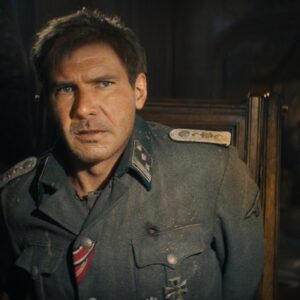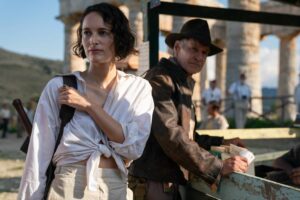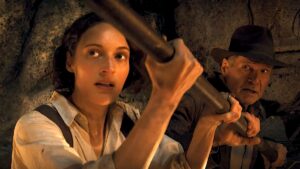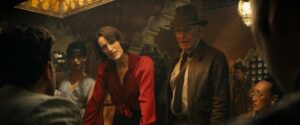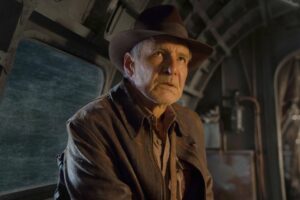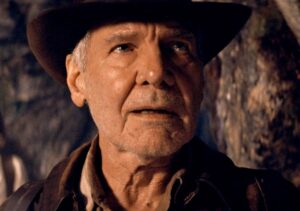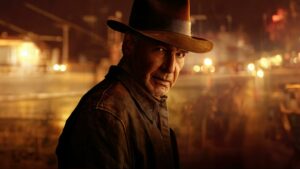Directed by James Mangold | Written by Mangold, Jez Butterworth, John-Henry Butterworth and David Koepp | 154 min | ▲▲▲△△
It’s a little hard to believe this movie exists, isn’t it?
This comes 15 years after the last one, the much-derided Kingdom Of The Crystal Skull and 34 years since the end of the original trilogy, The Last Crusade — my reviews of the first four movies can be found here — with the lead, Harrison Ford, in his late 70s.
Despite a rep as one of the grumpiest men in show-business (just behind Hugh Grant and Van Morrison, I suppose), Ford has been game to take another go at his most iconic characters as a senior citizen — witness his solid work in Blade Runner 2049 and Star Wars: The Force Awakens — so it makes sense he’d be up for one last crack of the bullwhip with a fifth Indiana Jones movie. This is maybe the most unlikely of his prominent roles, though, as it requires him to be an action hero. (For the record, I think his finest work lately has been on the Apple TV+ show Shrinking, go check it out.)
To further complicate matters, this is the first of the series where neither Steven Spielberg nor George Lucas are directly involved on the creative front. James Mangold, a capable filmmaker, has been brought in to helm this project, though he’s probably better known for heavier dramatic material like Girl Interrupted, Walk The Line, and Logan. So maybe we shouldn’t be surprised that the tone of this fifth adventure tends to the more downbeat, with far fewer of the sillier (or funnier) notes of the earlier films. (With Paramount no longer a producer, it doesn’t even start with a shot of a hill, mimicking the studio logo.)
Even a wild third act plot development, one that you can imagine in Spielberg’s hands would’ve been presented with wondrous flourish, is done here in an entirely matter-of-fact way.
The opening of Indiana Jones movies are always a highlight, so my expectations of this one were accordingly pretty high: We flash back to the last days of the Second World War, with the famed archeologist trying to stop the Nazis from absconding with a trainload of European antiquities, his associate Basil Shaw (Toby Jones) along for the ride. This would’ve probably made more sense with Marcus Brody at Indy’s side, but with Denholm Elliot having passed I suppose they needed to produce another new character with a fresh obsession: The work of ancient Greek mathematician Archimedes, especially a doohickey he invented called the Antikythera mechanism, the dial of the title. (This thing actually exists and has puzzled scientists for years.)
The dial (or, at least half of it) is on the Nazi’s train, along with a Nazi scientist, Jürgen Voller (Mads Mikkelsen), who’s also keen on it.
The opening few minutes — encompassing a nighttime motorcycle chase in rainy weather, and a series of fights through and over the top of the train — are a contrasting reminder of the gift Spielberg has with action choreography.
Consider the opening to The Last Crusade, which while it takes place in the desert sun otherwise has a few similarities to this one — a chase over land and on a train. The reason the earlier film’s sequence is objectively so much better is because much of the action is practical, with stunt people on location. This, on the other hand, looks sludgy, with an overuse of CGI in most of the shots. I was never convinced any of it takes place outside a studio. The whole sequence looks like it’s been computer animated.
When you add to that the abysmal de-aging tech they apply to Harrison Ford — this feels like an Indiana Jones video game, solidly in the uncanny valley. This is a very poor start.
Fortunately, things get better. Indy wakes up in his easy chair. It’s August 1969, in New York, and a ticker tape parade is planned for the recently returned Apollo astronauts. As fake and studio-bound as the opening was, this vision of sunny, summery and solidly 50+ years ago Manhattan feels tactile and real.
Professor Indiana Jones is still teaching, now at New York’s Hunter College, living in a crappy apartment in what looks like the upper east side. His neighbours are 20-somethings who like to blast the Beatles and Bowie, which makes Indy miserable. But then, he’s got plenty of reason to be unhappy: Marion (Karen Allen) has left him, and his boy died in Vietnam. He’s about to retire, but to what kind of life isn’t clear. Whatever his previous glories, in the face of moon rockets nobody cares about history, least of all his disengaged students. One of his only friends is one of his oldest, Sallah (John Rhys-Davies), who now drives a yellow cab.
Helena Shaw (Phoebe Waller-Bridge) comes back into Indy’s life — she’s Basil’s daughter and Indy’s goddaughter, which gives him an avuncular affection for her even though he hasn’t seen her in years. She’s chasing her father’s obsession, too, the device. At one point Indy asks her why she wants to find the thing that drove her father crazy. She responds, “Wouldn’t you?” Instant flashback to The Last Crusade.
That nostalgia for this character and the beloved films we all know is baked into this one. We’ve also been down this road once before, with Crystal Skull, a film I thought worked really well for the first half an hour or so, but then fell apart — not because of the elements of fantasy in the plot, but because of the silliness in the action set-pieces.
That’s not really an issue here because Mangold is a more serious filmmaker of fantasy material — even when the story delivers a twist that many might find ridiculous, he continues to play it straight. And the set-pieces are mostly satisfying — I’ll never believe tuk-tuks could ever reach the speed we see in this film, but that’s hardly the most outrageous thing we’re asked to buy into.
This isn’t a movie where the plot tends to make a whole lot of sense — we’ve got 2000-year-old shipwrecks full of eels and skeletons that should’ve long been dust, we’ve got a kid sidekick that gets brought along for no good reason other than to provide character development for Helena. Oh, and that kid, completely underwritten, learns how to fly an airplane on his own with barely a lesson.
But I’ll tell you where it works: in the connection between Ford and Waller-Bridge. She’s this movie’s Most Valuable Player, her vibe somewhere between Katherine Hepburn and Geena Davis, wordy and witty and caustic in all the right ways. Her surprisingly underhanded motivations add a welcome frisson to her relationship with her godfather. I appreciated it when she said she wouldn’t take ethics lessons from a grave robber.
Mads Mikkelsen also brings another excellent villain to a catalogue of them, from James Bond to Dr Strange. He haunts the film in ways that feel practically supernatural. The unspoken horror of his character is at one point he’s about to receive a presidential recognition for his contribution to the American space program, despite his history with the Nazis — the implication is the Yanks were happy to hold their noses and employ evil in order to beat the Soviets to the moon.
And, finally, Ford is wonderful. A scene toward the end almost suggests everything that went before was a dream — it comes with a moment of warmth and wistfulness that got me right in the feels. (Too bad it took two and a half hours to get there — this is the longest Indiana Jones adventure, and it didn’t need to be. )
Ford’s physicality — fighting muscular antagonists half his age like Boyd Holbrook — is a stretch, but suspending disbelief is what this franchise has been about since the beginning. To enjoy this, you’ll be required some extra heavy lifting in that department.









